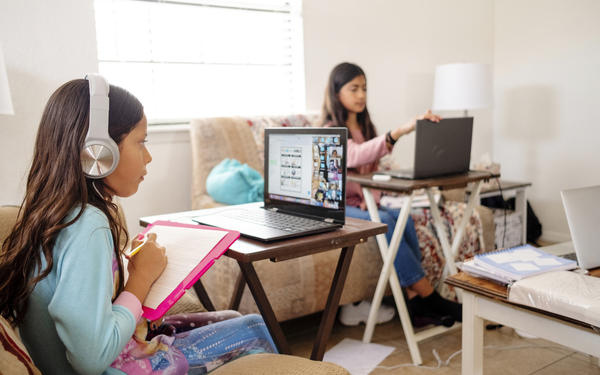Teachers’ perspectives on teaching in lockdown
A blog from Sam Derby on what it has been like for teachers on the frontline of social impact.

Teachers on the frontline of social impact
Before we talk about teaching, we need to talk about everything else that schools and teachers do. As Chair of Governors at a state primary school with a disproportionately high percentage of pupil’s eligible for free school meals, what I have been hearing from the Senior Leadership Team is at least fifty percent to do with supporting families to access food and basic supplies. For many families, the school is a lifeline. I have heard directly of late-night text messages asking for help to get food, of free breakfast deliveries being put together along with worksheets, and of teachers deeply concerned that when national schemes don’t work - such as the huge problems with the Edenred free school meal vouchers - it is teachers who have to pick up the slack.
The same goes for vulnerable children. The most vulnerable - those with social workers at least aware of their particular situation - are eligible to come into school. But many are being kept at home, raising enormous safeguarding concerns. This early article in the Guardian covers similar issues at a secondary school in London; while much focus in education has naturally been on how teachers are reacting to the challenges to their classroom practice, it is easy to forget that the classroom is only a small part of their role.
“Our leaders initially focused their attention on content delivery. But well-being swiftly emerged as priority one. Suddenly we had the issue of a lot of students potentially falling through the net – we couldn’t see them as well – we can’t see (their) expressions. Systems had to be put in place […] so that all students have a space, a digital space they could come into and speak to key people in the school about how they were doing.” Iain Sachdev, Principal of the International School of Monza, Milan, whose team moved their school online in 24 hours.
What the changes look like in practice
What we know of the working day of a teacher in this context is that for many (about two-thirds for teachers in the UK) it has become shorter – unsurprising as there is much less behaviour-management to do – but also much more complex. Not only do teachers have their own caring responsibilities to think about – in total, over a third of all teachers are educating their own kids whilst working – but they have been forcibly removed not only from their classrooms but also from the bulk of the resources they rely on to prepare and teach lessons each day. Teachers in the UK are working from bedrooms and living rooms as much as from home offices, and given that for younger teachers that often means a small space in a shared house, there are clear logistical challenges to overcome before they start thinking about teaching content.
As this graph shows, the living room was the most popular location for all age groups. However, the bedroom was next most popular for those in their 20s, then dining rooms for those in their 30s and 40s, followed by the study for those in their 50s.
Although a huge amount has changed, and technology is playing an important role, it is not the case that teaching has literally moved online in the sense of live-streaming, except in the private-school sector. For state primaries, only 2% of teachers reported having live-streamed teaching, and the percentage was only 6% in state secondaries. In the fee-paying sector the numbers are 52% and 66% respectively. It is likely that this is down to a combination of factors: private school students are more likely to have access to a stable online device with a keyboard, and their teachers are more likely to have been provided with an appropriate platform and the training to use it effectively; they are also likely to have smaller class sizes and so be more able to manage an effective online session. And, of course, there is an acute awareness within the fee-paying sector that schools need to be perceived to be providing value for money throughout the period.
Distance-learning as a catalyst for rapid change
Of course teachers have been rapidly acquiring and practising new skills too, many of them digital. Learning to use a digital platform in theory is one thing, but encountering and solving the day-to-day practical barriers to effective teaching and learning is quite another. Teachers across the world surveyed by Cambridge University Press articulated some of these barriers, and how they have overcome them,
“Challenges today include some struggles in creating a lesson package that I will deliver to my students since some features on the platform are very limited. I have other avenues to deliver my lessons to my students even [if] we are at [our] own homes and will explore how to use those.” Joanabelle, Philippines - Maths teacher
“I had my first Zoom call with my teachers and it was awesome. I shared the proposal of LabXchange with them and they were enthusiastic. We have organized an online tutoring for all staff on Friday. We are excited.” Kavita, India - School leader
“I tried to create a video of myself teaching with a whiteboard and marker. Keeping the phone in the right position to shoot the video took me 15 minutes. It took me 2 hours to create a 20 minute video… oh how I miss regular teaching. I am not a tech-savvy person but I realise that we have to change and embrace change with time. My son helped me with the video and taught me how to edit and compile it in no time. I became the student and he the teacher. He scolded me when I could not get in right even after explaining it to me 5 times. Now I know how it feels to be at the receiving end.” Sudha, Malaysia - Primary teacher
In England, teachers surveyed by Teacher Tapp in late March reported the same relatively high levels of confidence using technology to teach as they had twelve months ago, although many also reported having completed training in using those technologies in the first week of the lockdown. CPD is likely to see very high engagement given the need to think differently in the current environment, plus the relative time available to teachers to reflect on their practice. Teachers on Twitter have been sharing their CPD diaries, revealing that CPD on all topics, not just online skills or pedagogies, has become popular.
The big question many are asking is, how much of this new world is here to stay in education? Research is underway (for example from Educate Ventures and Cambridge University Press) to try to get an idea of this. The answer will be discovered only in the coming months and years, but it seems likely that the vast amount of experimentation with new modes of teaching and learning will produce some lasting change in education. School leaders are noting a change in mindset in their staff - not just the ability to learn new technical skills, but a different approach to thinking about teaching itself.
“The environment of uncertainty has had the effect of moving teachers and teams into experimentation mode” says Erika Carlson, the Head Principal at Wuhan Yangtze International School whose students were spread across four continents when the lockdown came. She noted that the pandemic has pushed her and her team to “think about using their resources and teams and tools and people in completely different ways. This change in teacher mindset will be the most important change, more so than the specifics of the tools they were using”.
What this change in mindset means will not be clear for some time. But we are surely likely, as we reflect in decades to come, to be looking back at this moment in the history of education and tracing those changes back to the COVID-19 generation of teachers, and what they achieved, with the greatest respect.




